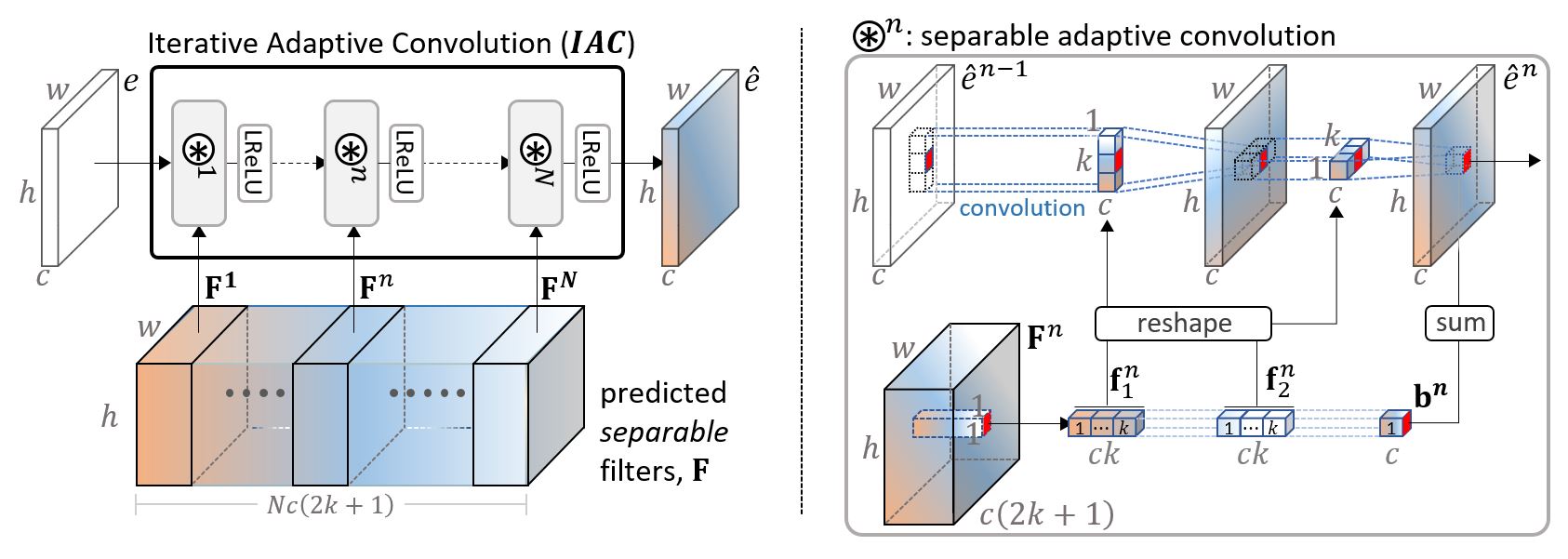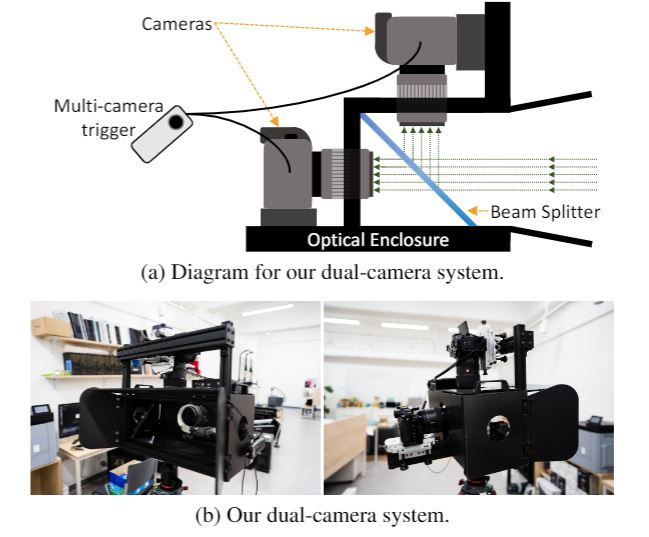This repository contains the official PyTorch implementation of the following paper:
Iterative Filter Adaptive Network for Single Image Defocus Deblurring
Junyong Lee, Hyeongseok Son, Jaesung Rim, Sunghyun Cho, Seungyong Lee, CVPR 2021
Click here
Our deblurring network is built upon a simple encoder-decoder architecture consisting of a feature extractor, reconstructor, and IFAN module in the middle. The feature extractor extracts defocused features and feeds them to IFAN. IFAN removes blur in the feature domain by predicting spatially-varying deblurring filters and applying them to the defocused features using IAC. The deblurred features from IFAN is then passed to the reconstructor, which restores an all-in-focus image.
The IAC layer iteratively computes feature maps as follows (refer Eq. 1 in the main paper):
Separable filters in our IAC layer play a key role in resolving the limitation of the FAC layer. Our IAC layer secures larger receptive fields at much lower memory and computational costs than the FAC layer by utilizing 1-dim filters, instead of 2-dim convolutions. However, compared to dense 2-dim convolution filters in the FAC layer, our separable filters may not provide enough accuracy for deblurring filters. We handle this problem by iteratively applying separable filters to fully exploit the non-linear nature of a deep network. Our iterative scheme also enables small-sized separable filters to be used for establishing large receptive fields.
To further improve the single image deblurring quality, we train our network with novel defocus-specific tasks: defocus disparity estimation and reblurring.
Disparity Map Estimation exploits dual-pixel data, which provides stereo images with a tiny baseline, whose disparities are proportional to defocus blur magnitudes. Leveraging dual-pixel stereo images, we train IFAN to predict the disparity map from a single image so that it can also learn to more accurately predict blur magnitudes.
Reblurring, motivated by the reblur-to-deblur scheme, utilizes deblurring filters predicted by IFAN for reblurring all-in-focus images. For accurate reblurring, IFAN needs to predict deblurring filters that contain accurate information about the shapes and sizes of defocus blur. Based on this, during training, we introduce an additional network that inverts predicted deblurring filters to reblurring filters, and reblurs an all-in-focus image.
We present the Real Depth of Field (RealDOF) test set for quantitative and qualitative evaluations of single image defocus deblurring. Our RealDOF test set contains 50 image pairs, each of which consists of a defocused image and its corresponding all-in-focus image that have been concurrently captured for the same scene, with the dual-camera system. Refer Sec. 1 in the supplementary material for more details.
Tested environment
-
Environment setup
$ git clone https://github.com/codeslake/IFAN.git $ cd IFAN $ conda create -y --name IFAN python=3.8 && conda activate IFAN # for CUDA10.2 $ sh install_CUDA10.2.sh # for CUDA11.1 $ sh install_CUDA11.1.sh
-
Datasets
-
Download and unzip test sets (DPDD, PixelDP, CUHK and RealDOF) under
[DATASET_ROOT]:├── [DATASET_ROOT] │ ├── DPDD │ ├── PixelDP │ ├── CUHK │ ├── RealDOFNote:
[DATASET_ROOT]is currently set to./datasets/defocus_deblur/, which can be modified byconfig.data_offsetin./configs/config.py.
-
-
Pre-trained models
-
Download and unzip pretrained weights under
./ckpt/:├── ./ckpt │ ├── IFAN.pytorch │ ├── ... │ ├── IFAN_dual.pytorch
-
## Table 2 in the main paper
# Our final model used for comparison
CUDA_VISIBLE_DEVICES=0 python run.py --mode IFAN --network IFAN --config config_IFAN --data DPDD --ckpt_abs_name ckpt/IFAN.pytorch
## Table 4 in the main paper
# Our final model with N=8
CUDA_VISIBLE_DEVICES=0 python run.py --mode IFAN_8 --network IFAN --config config_IFAN_8 --data DPDD --ckpt_abs_name ckpt/IFAN_8.pytorch
# Our final model with N=26
CUDA_VISIBLE_DEVICES=0 python run.py --mode IFAN_26 --network IFAN --config config_IFAN_26 --data DPDD --ckpt_abs_name ckpt/IFAN_26.pytorch
# Our final model with N=35
CUDA_VISIBLE_DEVICES=0 python run.py --mode IFAN_35 --network IFAN --config config_IFAN_35 --data DPDD --ckpt_abs_name ckpt/IFAN_35.pytorch
# Our final model with N=44
CUDA_VISIBLE_DEVICES=0 python run.py --mode IFAN_44 --network IFAN --config config_IFAN_44 --data DPDD --ckpt_abs_name ckpt/IFAN_44.pytorch
## Table 1 in the supplementary material
# Our model trained with 16 bit images
CUDA_VISIBLE_DEVICES=0 python run.py --mode IFAN_16bit --network IFAN --config config_IFAN_16bit --data DPDD --ckpt_abs_name ckpt/IFAN_16bit.pytorch
## Table 2 in the supplementary material
# Our model taking dual-pixel stereo images as an input
CUDA_VISIBLE_DEVICES=0 python run.py --mode IFAN_dual --network IFAN_dual --config config_IFAN --data DPDD --ckpt_abs_name ckpt/IFAN_dual.pytorchNote:
- Testing results will be saved in
[LOG_ROOT]/IFAN_CVPR2021/[mode]/result/quanti_quali/[mode]_[epoch]/[data]/.[LOG_ROOT]is set to./logs/by default. Refer here for more details about the logging.
- Options
--data: The name of a dataset to evaluate.DPDD|RealDOF|CUHK|PixelDP|random. Default:DPDD- The folder structure can be modified in the function
set_eval_path(..)in./configs/config.py. randomis for testing models with any images, which should be placed as[DATASET_ROOT]/random/*.[jpg|png].
- The folder structure can be modified in the function
If you find this code useful, please consider citing:
@InProceedings{Lee_2021_CVPR,
author = {Lee, Junyong and Son, Hyeongseok and Rim, Jaesung and Cho, Sunghyun and Lee, Seungyong},
title = {Iterative Filter Adaptive Network for Single Image Defocus Deblurring},
booktitle = {The IEEE Conference on Computer Vision and Pattern Recognition (CVPR)},
month = {June},
year = {2021}
}
Open an issue for any inquiries. You may also have contact with junyonglee@postech.ac.kr
All material related to our paper is available by following links:
| Link |
|---|
| The main paper |
| Supplementary |
| Checkpoint Files |
| The DPDD dataset (reference) |
| The PixelDP test set (reference) |
| The CUHK dataset (reference) |
| The RealDOF test set |
This software is being made available under the terms in the LICENSE file.
Any exemptions to these terms require a license from the Pohang University of Science and Technology.
Project ‘COUPE’ aims to develop software that evaluates and improves the quality of images and videos based on big visual data. To achieve the goal, we extract sharpness, color, composition features from images and develop technologies for restoring and improving by using them. In addition, personalization technology through user reference analysis is under study.
Please check out other Coupe repositories in our Posgraph github organization.


-blue.svg?style=flat)









